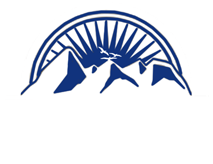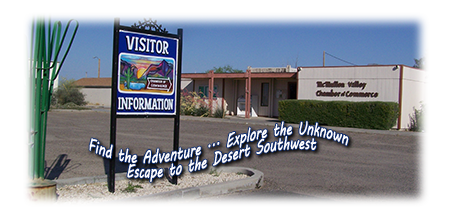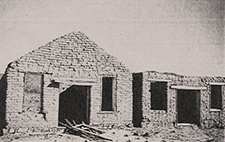
66710 Hwy 60
(PO Box 700)
Salome, Arizona 85348
Phone: (928) 859-3846
Email: mcmullencoc@tds.net
Providing online information for the communities of the Arizona Outback
since 1997 ... www.AZOutback.net

HARRISBURG, ARIZONA
(NEAR SALOME, ARIZONA)
Harrisburg is located five miles southeast of Salome, off the Salome-Buckeye Road.
Early in 1886, Horace E. Harris examined the prospects in the Ellsworth Mining District. Impressed, he convinced Governor Fred Tritle to provide the funds to move a five-stamp mill from near Prescott a hundred miles across forests and deserts, to a site below his thirty claims, near Centennial. In the fall, Harris laid out a new townsite and unblushingly named it after himself, while superintendent William Beard prepared the mill for operation.
Early the next year a mill began to roll. While prospectors scoured the surrounding hills, Mexican placeros dug for gold in the gravel of Centennial Wash. Harrisburg itself became the supply center for 200 people in the Harqua Hala District. The post office was established April 29, 1887 and discontinued September 29, 1906.
Harrisburg was a ghost town by World War IA new gold discovery in the fall of 1888 brought more excitement to the camp. While picking the rocky hills six miles west of town, veteran prospectors caught the sight of gold. Word of the discovery quickly circulated and the territorial press touted it as a “bonanza”. By January, 1889 a rush was on. The belief in the magic number “9” – 1849 to California, ’59 to Pike’s Peak, ’69 to White Pine, ’79 to Tombstone – sparked imaginations.
Harrisburg was a ghost town by World War I – noted by the La Paz Historical Commission. It’s not clear, based on historical information, but Harrisburg may have been referred to as Orville, and/or Centennial.
Old Hassayampers, as well as Tombstonians, ranging from Wyatt Earp to the miner’s “angel”, Nellie Cashman, came early to the district. The San Francisco Examiner’s George Hearst, sent representatives to offer $200,000 for the richest claims.
But within a year the bottom fell out when surface veins vanished. Though the boom was over, George Bowers and A.G. Hubbard sank shafts, installed hoists and built a six-mile pipeline from Harrisburg to their new twenty-stamp mill. During 1891-93, they recovered $1.6 million in gold.
With the increased activity, Harrisburg expanded with saloons, restaurants, butcher shops, a blacksmith and bakeries. Bowers laid out the Harqua Hala townsite early in 1891, five miles west of Harrisburg, near the mines. Two years later they sold claims to London investors for $1.25 million, but soon thereafter ore reserves disappeared. The water supply dried up, shafts caved in, and Anglo-Saxon work crews who replaced the Mexican miners fell sick in the desert sun.
Thereafter, the Harqua Hala mines periodically revived when investors tried to reopen them. Harrisburg itself declined after 1905, when the community of Salome, on the railroad, became the local trade center.
There was believed to be 30 people living there with one saloon and one general store and stamp mills. Today the valley is populated with mini ranches, a gravel operation and full fledged working ranches.
HARRISBURG CEMETERY, HARRISBURG
How to get there
1. Travel south east on Salome Road approximately 5 miles and you will come to a historical marker on the (west) of the road. .... It reads ‘Harrisburg’.
2. Slightly south of this marker on the right side of the road, just past 40725 Salome Road, there is a road/trail with a ‘Y’ leading off the black top on your right. ... It is a little hard to identify.
3. Follow the road west mile until you come to the main gate of the Harrisburg Ranch.
4. Turn left following the fence line on the west side of the fence.
You will travel past some old structures along the way, continue about 1/3 mile. You will come to the beautiful Pioneer Cemetery of Harrisburg. Very well maintained and cared for by the local residents.
5. The cemetery is fenced with a large stone monument in the center, which was erected by the La Paz Sheriff’s Posse in December 1985.
There are a few headstones standing that are legible. Several small white rock enclosures outlining additional graves, but no names or dates indicating those interred.
In total there are approximately 33 interments.














